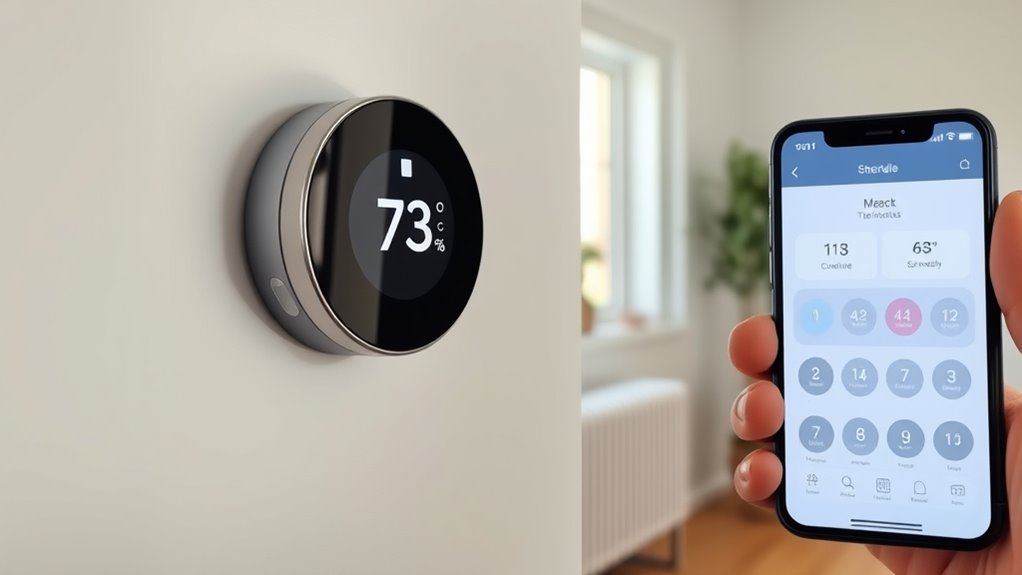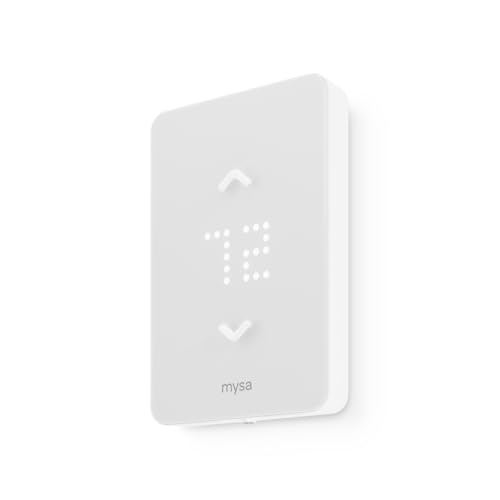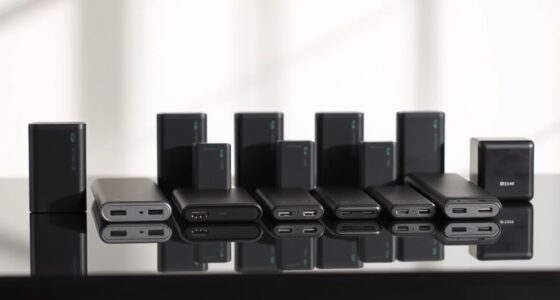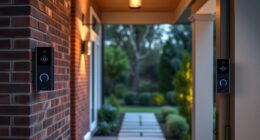If you’re looking for the best smart control thermostats for baseboard heaters in 2025, I recommend options like the Mysa LITE and full Mysa for easy DIY installation and seamless smart home integration with Apple, Google, and Alexa. The meross Smart Thermostat is versatile but less suitable for electric baseboards. MOES offers simple manual controls alongside smart features. Stay with me to discover which option fits your setup perfectly and how to get the most from your system.
Key Takeaways
- Mysa LITE and full version are ideal for high-voltage electric baseboard heaters with easy DIY installation and smart home integration.
- Compatibility requires four-wire setups, including neutral or second live wire, suitable for 120V-240V electric systems.
- The full Mysa offers advanced features like humidity alerts and adaptive display, while Mysa LITE provides straightforward control.
- meross and MOES thermostats support multiple ecosystems but may require trial wiring and are incompatible with electric baseboards.
- Consider system load capacity, wiring requirements, and smart home ecosystem compatibility when choosing the best thermostat for baseboard heating.
Mysa Smart Thermostat LITE for Baseboard Heaters
If you have high-voltage electric baseboard heaters and want a smart thermostat that’s easy to install and offers precise control, the Mysa Smart Thermostat LITE is an excellent choice. It replaces standard 4-wire thermostats and works with 120V-240V systems, including baseboards, wall heaters, and convectors. Thanks to its sleek LCD display and wall-mount design, it looks modern and fits seamlessly into your space. Setup is straightforward, often taking about 15 minutes with the included video guide—no electrician needed. Plus, its WiFi connection enables remote control, scheduling, and voice commands via Apple HomeKit, Alexa, or Google Assistant.
Best For: homeowners with high-voltage electric baseboard heaters seeking an easy-to-install, smart, and energy-efficient thermostat solution.
Pros:
- Easy DIY installation with clear video guides, no electrician needed
- Seamless remote control and scheduling via WiFi, compatible with Alexa, Google, and Apple HomeKit
- Sleek modern design with LCD display that fits well into various interior styles
Cons:
- Only compatible with high-voltage (120V-240V) systems with at least four wires, not suitable for low-voltage setups
- Does not display humidity or track energy usage in LTE version
- Requires proper wiring and compatibility checks to ensure optimal functioning
meross Smart Thermostat for Electric Baseboard and In-Wall Heaters
The meross Smart Thermostat stands out as an excellent choice for homeowners seeking reliable, app-enabled control of high-voltage electric baseboard and in-wall heaters. It supports 120V-240V systems, handling up to 16A and nearly 2,000W at 120V, making it versatile for various setups. Compatible with Apple HomeKit, Alexa, Google Assistant, and SmartThings, it offers voice control and remote management. Its sleek LCD display and easy wall-mount design blend into any space. Installation takes under 30 minutes with proper wiring, and the app provides customizable schedules, energy monitoring, and open window detection. Overall, it’s a feature-rich, cost-effective solution for smart heating control.
Best For: homeowners seeking a reliable, app-controlled smart thermostat for high-voltage electric baseboard and in-wall heaters with versatile voice assistant compatibility.
Pros:
- Supports 120V-240V systems with up to 16A and nearly 2,000W, offering broad compatibility for various electric heating setups.
- Integrates seamlessly with Apple HomeKit, Alexa, Google Assistant, and SmartThings for voice and remote control.
- Features customizable scheduling, energy monitoring, and open window detection, enhancing energy efficiency and convenience.
Cons:
- Does not support underfloor heating systems.
- Installation and wiring may require trial-and-error, especially for users unfamiliar with high-voltage wiring.
- Lacks multi-location management within the app, which can be limiting for users controlling multiple thermostats across different sites.
Mysa Smart Thermostat for Electric Baseboard Heaters
For homeowners seeking precise control over electric baseboard heaters, the Mysa Smart Thermostat stands out thanks to its compatibility with high-voltage systems and robust Wi-Fi connectivity. It’s designed for 120–240V systems, supporting loads up to 3800W at 240V, but requires at least four wires, including a neutral or second live wire. The thermostat offers remote control through a free app, allowing quick scheduling and adjustments, plus integration with Alexa, Google Assistant, and Apple HomeKit. Its compact, 40% smaller design simplifies installation, and features like adaptive display brightness and humidity alerts enhance user comfort and convenience.
Best For: homeowners with high-voltage electric baseboard heating systems seeking easy installation, remote control, and smart home integration.
Pros:
- Compatible with 120–240V systems and loads up to 3800W at 240V, suitable for most electric baseboard heaters
- Compact, 40% smaller design simplifies installation and reduces obtrusiveness
- Supports remote control and scheduling via a free app, along with voice assistant integration (Alexa, Google, Apple HomeKit)
Cons:
- Requires at least four wires, including a neutral or second live wire, which may not be present in older systems
- Not compatible with low-voltage or two-wire installations
- Setup and compatibility verification are essential before purchase, especially for existing or older wiring configurations
MOES Programmable Smart Thermostat for Electric Heaters
The MOES Programmable Smart Thermostat stands out as an excellent choice for homeowners seeking precise control over their electric baseboard heaters. It offers seamless connectivity with 2.4G WiFi, Alexa, Google Home, and the TUYA/Smart Life app, allowing remote control and voice commands. Designed for high-voltage systems, it supports 120V and 240V applications. The thermostat features a clear, glare-free frosted display and an easy-grip knob for manual adjustments. With programmable scheduling and remote access, it helps optimize energy use, reduce costs, and enhance comfort. Overall, it’s a reliable, versatile option for modern heating management.
Best For: homeowners seeking precise, remote-controlled temperature management for their electric baseboard heaters with smart home integration.
Pros:
- Compatible with 2.4G WiFi, Alexa, Google Home, and TUYA/Smart Life app for versatile control options
- Supports high-voltage systems (120V/240V), making it suitable for various electrical setups
- Features a glare-free frosted display and easy-grip manual knob for user convenience
Cons:
- Requires at least four wires, including neutral or second live wire, for proper installation
- May be more complex to install for those unfamiliar with high-voltage wiring
- Limited to electric heaters; not suitable for other heating types
meross Smart Thermostat for Home, WiFi Thermostat
If you’re looking for a versatile smart thermostat compatible with most HVAC systems, the meross Smart Thermostat (Model MTS300) stands out as a solid choice—except for electric baseboard heaters. It offers Wi-Fi control, supporting 95% of HVAC setups, including heat pumps and conventional systems, but requires a C-wire and only works on 2.4GHz networks. Its sleek design features an LED display, and it supports Matter technology, allowing integration with Apple Home, Alexa, Google Assistant, and Samsung SmartThings. Easy to install and set up, users praise its reliable performance, scheduling, and remote control, making it a cost-effective upgrade for energy management.
Best For: homeowners seeking a versatile, easy-to-install smart thermostat compatible with most HVAC systems (excluding electric baseboard heaters) and integrated with popular smart home platforms.
Pros:
- Supports 95% of HVAC systems, including heat pumps and conventional setups
- Compatible with Matter technology for seamless integration with Apple Home, Alexa, Google Assistant, and Samsung SmartThings
- Easy DIY installation with clear instructions, quick setup, and reliable performance
Cons:
- Requires a C-wire for proper operation, which may not be available in all homes
- Only supports 2.4GHz Wi-Fi networks, limiting compatibility with dual-band routers
- Lacks built-in geofencing, relying on automations for location-based control
Factors to Consider When Choosing a Baseboard Heater Thermostat Smart Control

When selecting a smart thermostat for your baseboard heater, I consider factors like compatibility with my existing system and how easy it is to install. I also look for features like smart home integration, programmable schedules, and energy-saving options to make my setup more efficient. These points help guarantee I choose a thermostat that fits my needs and simplifies my heating control.
Compatibility With Systems
Choosing a smart control thermostat for your baseboard heaters requires ensuring compatibility with your existing electrical system. First, make sure the thermostat is designed for high-voltage (120V-240V) systems, not low-voltage or two-wire setups. Verify that your system needs at least four wires, including a neutral or second live wire, for proper operation. It’s also vital to confirm the thermostat can handle the maximum wattage and load of your heater model. Additionally, consider whether the thermostat integrates with your current smart home ecosystem, such as Wi-Fi, Zigbee, or Z-Wave. Compatibility with your system’s control protocols—like Wi-Fi, Bluetooth, or proprietary platforms—is essential for seamless operation. Ensuring these factors match will help you avoid compatibility issues and maximize your thermostat’s performance.
Ease of Installation
Ease of installation is a crucial factor to consider because a complicated setup can discourage even handy DIYers. I recommend choosing a thermostat compatible with your existing wiring, usually requiring at least four wires, including a neutral or second live wire. Look for models with clear, step-by-step instructions or video tutorials that simplify the process. Opt for thermostats with user-friendly mounting options, like wall plates that align easily with standard electrical boxes, to save time and effort. Confirm the device supports quick pairing with your Wi-Fi network and includes troubleshooting guides for common issues. Finally, think about thermostats designed specifically for DIY installation, which often feature minimal wiring adjustments and straightforward setup steps, making the entire process smoother and less stressful.
Smart Home Integration
Integrating a smart thermostat with your existing home automation setup can substantially enhance convenience and control. I recommend choosing a thermostat that supports popular platforms like Apple HomeKit, Amazon Alexa, or Google Assistant, so voice commands and automation are seamless. Make sure it has Wi-Fi connectivity for remote management via mobile apps, allowing you to adjust settings from anywhere. Look for devices that support automation routines such as geofencing or custom schedules, which help optimize energy use and comfort. Compatibility with your current smart home ecosystem is essential for smooth multi-device control. Finally, consider whether the thermostat offers firmware updates and open API support. These features ensure your device stays current and can expand its functionality as your smart home evolves.
Programmable Scheduling
When selecting a smart thermostat for your baseboard heaters, programmable scheduling is a key feature to contemplate because it allows you to set specific times for heating to turn on or off, ensuring both comfort and energy savings. With the ability to create daily or weekly schedules, you can customize temperature settings for different times of the day, matching your routine. Automatic adjustments based on these schedules help prevent unnecessary heating during unoccupied periods, reducing costs. Some advanced thermostats offer seasonal adjustments, holiday modes, and remote schedule overrides, adding flexibility. Properly configured schedules maintain consistent comfort while optimizing energy use, making your heating system more efficient and tailored to your lifestyle.
Energy Saving Features
Energy-saving features are an essential consideration when choosing a smart thermostat for your baseboard heaters. These features can substantially reduce energy consumption and lower your utility bills. For example, scheduling and auto-away modes automatically adjust heating when rooms are unoccupied, preventing unnecessary energy use. Adaptive display brightness minimizes power waste by dimming screens in low-light conditions. Remote control capabilities allow me to fine-tune settings from anywhere, ensuring heating isn’t wasted when it’s not needed. Energy reports and usage analytics help identify patterns, so I can optimize my heating schedules for maximum efficiency. Additionally, built-in open window detection pauses heating if a window is left open, avoiding wasteful energy loss. These features make smart thermostats more intelligent and energy-conscious choices for my home.
User-Friendly Controls
Choosing a smart thermostat with user-friendly controls is essential because it makes managing your heating system straightforward and stress-free. I look for a clear, intuitive interface with simple menus and easy-to-understand settings. Physical controls, like tactile knobs or buttons, make manual adjustments quick and hassle-free. A digital display that shows real-time temperature readings and system status helps me stay informed at a glance. Smart thermostats with app controls are a game-changer, allowing me to adjust settings, schedule heating, and customize from anywhere using my phone. Additionally, simplified setup processes and guided troubleshooting make installation and ongoing use much easier, reducing frustration. Overall, user-friendly controls ensure I can operate my heater efficiently without a steep learning curve.
Display and Interface
A clear and well-designed display is key to making your thermostat easy to use. A crisp LCD or LED screen allows you to quickly see temperature settings and system status at a glance. Touchscreen interfaces streamline navigation and control, reducing reliance on physical buttons, which makes adjustments more intuitive. Brightness adjustment features are essential for visibility in different lighting conditions and help minimize glare. Some thermostats display extra information like humidity, energy consumption, or Wi-Fi status, giving you useful insights without extra devices. User-friendly interfaces often include large, tactile controls or knobs for manual adjustments, making it simple to tweak settings when needed. Overall, a good display and interface enhance usability, ensuring your thermostat is both functional and easy to operate.
Durability and Warranty
Durability and warranty are essential factors when selecting a smart control thermostat for your baseboard heaters because a reliable device saves you money and hassle in the long run. A well-built thermostat should use high-quality, UL-certified components to guarantee safety and longevity. Look for models offering at least a 2-year warranty, which reflects confidence in the product’s durability. The housing material, whether high-grade plastic or metal, impacts resistance to wear, heat, and environmental factors. A sturdy design with minimal moving parts and robust circuitry helps prevent failures over time. Additionally, an extended warranty and responsive customer support can address potential issues, ensuring your thermostat remains functional longer. Prioritizing durability and warranty protects your investment and guarantees consistent heating performance.
Frequently Asked Questions
How Secure Are These Smart Thermostats Against Hacking?
Smart thermostats are generally secure, but no device is completely invulnerable. I guarantee mine are protected by strong, unique passwords and keep the firmware updated regularly. I also enable two-factor authentication when possible. While the risk is low, it’s wise to stay cautious and monitor your network activity. Overall, with proper security measures, these thermostats are quite safe against hacking attempts, giving me peace of mind.
Can These Thermostats Integrate With Existing Smart Home Systems?
Yes, these smart thermostats can typically integrate with existing smart home systems. I’ve found most are compatible with popular platforms like Alexa, Google Home, and Apple HomeKit. They often connect via Wi-Fi or Zigbee, making setup straightforward. I recommend checking each model’s specifications to verify it works seamlessly with your current devices. Integration makes controlling your baseboard heaters more convenient and helps create a unified smart home experience.
What Is the Typical Installation Process for These Devices?
I start by turning off the power to my baseboard heaters at the breaker. Then, I remove the old thermostat and disconnect the wires. Next, I connect the new smart thermostat’s wires, following the manufacturer’s instructions carefully. I mount the device securely on the wall, turn the power back on, and run through the setup process on the app or device. It’s straightforward and usually takes about 30 minutes.
Do They Support Voice Control Through Platforms Like Alexa or Google Assistant?
Yes, most smart control thermostats for baseboard heaters support voice control through platforms like Alexa and Google Assistant. I love how easy it is to adjust my thermostat just by speaking, which adds convenience and saves time. These integrations work seamlessly, allowing me to control my heating even when I’m across the room or if I have my hands full. It’s a simple, hands-free way to stay comfortable.
Are Firmware Updates Automatically Applied or Manually Initiated?
Firmware updates are typically automatically applied, but some thermostats allow manual initiation. I prefer automatic updates because they keep my system secure, bug-free, and up-to-date without hassle. However, I also appreciate the option to manually check and install updates when needed, giving me control over my device. Ultimately, I want seamless, worry-free performance paired with the flexibility to manage updates on my terms.
Conclusion
Choosing the right smart thermostat can markedly boost your comfort and energy savings. Did you know that homeowners with smart thermostats save up to 23% on energy bills? With options like the Mysa LITE and meross models, you can tailor your heating control exactly how you want. No matter which you pick, upgrading your baseboard heater thermostat is a smart move that’ll make your home more efficient and cozy in 2025.















